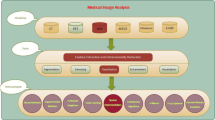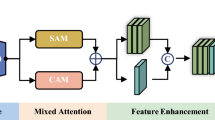Abstract
Providing accurate and speedy diagnosis and, in turn, treatment, automated medical image analysis plays a significant role in survival rate improvement. Inherent different kinds of uncertainties and complexities prove machine learning-based, particularly dictionary-learning-based classification approaches, very promisingly. This work concerns class-specific fuzzy discriminative dictionary learning using deep features on the continuum of our machine-learning-based medical image classifiers’ evolution path. In D3FC, a deep autoencoder generates a more relevant, representative, and compact features set. The distinctive-hidden information and inherent complexity and uncertainty of medical images are addressed using fuzzy-discriminative terms in the optimization function, simultaneously improving the inter-class-representation distance and intra-class-representation similarity. A comprehensive set of experiments on cancer tumor images from three different databases shows the outperformance of D3FC over related state-of-the-art competitions in accuracy, sensitivity, specificity, precision, convergence speed, and noise resilience. The meaningfulness of the experiments’ results is statistically verified.











Similar content being viewed by others
Explore related subjects
Discover the latest articles, news and stories from top researchers in related subjects.References
Aharon M, Elad M, Bruckstein A et al (2006) K-svd: an algorithm for designing overcomplete dictionaries for sparse representation. IEEE Trans Signal Process 54(11):4311
Chatfield K, Lempitsky VS, Vedaldi A, Zisserman A (2011) The devil is in the details: an evaluation of recent feature encoding methods. In: BMVC, vol 2, p. 8
Chen Y, Shi L, Feng Q, Yang J, Shu H, Luo L, Coatrieux JL, Chen W (2014) Artifact suppressed dictionary learning for low-dose ct image processing. IEEE Trans Med Imaging 33(12):2271– 2292
Chowdhary CL, Mittal M, Pattanaik P, Marszalek Z et al (2020) An efficient segmentation and classification system in medical images using intuitionist possibilistic fuzzy c-mean clustering and fuzzy svm algorithm. Sensors 20(14):3903
Clark K, Vendt B, Smith K, Freymann J, Kirby J, Koppel P, Moore S, Phillips S, Maffitt D, Pringle M et al (2013) The cancer imaging archive (tcia): maintaining and operating a public information repository. J Digit Imaging 26(6):1045–1057
Dai W, Xu T, Wang W (2012) Simultaneous codeword optimization (simco) for dictionary update and learning. IEEE Trans Signal Process 60(12):6340–6353
Elhamifar E, Vidal R (2011) Robust classification using structured sparse representation. In: CVPR 2011. IEEE, pp 1873–1879
Elmoufidi A, El Fahssi K, Jai-Andaloussi S, Sekkaki A, Gwenole Q, Lamard M (2017) Anomaly classification in digital mammography based on multiple-instance learning. IET Image Process 12 (3):320–328
Engan K, Aase SO, Husoy JH (1999) Method of optimal directions for frame design. In: , 1999. Proceedings., 1999 IEEE international conference on Acoustics, speech, and signal processing, vol 5. IEEE, pp 2443–2446
Fang H, Fan H, Lin S, Qing Z, Sheykhahmad FR (2021) Automatic breast cancer detection based on optimized neural network using whale optimization algorithm. Int J Imaging Syst Technol 31(1):425–438
Foldiak P (2003) Sparse coding in the primate cortex. The Handbook of Brain Theory and Neural Networks
Friedman M (1937) The use of ranks to avoid the assumption of normality implicit in the analysis of variance. J Amer Stat Assoc 32(200):675–701
Ghasemi M, Kelarestaghi M, Eshghi F, Sharifi A (2020) Fdsr: A new fuzzy discriminative sparse representation method for medical image classification. Artif Intell Med:101876
Ghasemi M, Kelarestaghi M, Eshghi F, Sharifi A (2020) T2-fdl: A robust sparse representation method using adaptive type-2 fuzzy dictionary learning for medical image classification. Expert Syst Appl:113500
Ghasemi M, Kelarestaghi M, Eshghi F, Sharifi A (2021) Afdl: a new adaptive fuzzy dictionary learning for medical image classification. Pattern Anal Applic 24(1):145–164
Gravel P, Beaudoin G, De Guise JA (2004) A method for modeling noise in medical images. IEEE Trans Med Imaging 23(10):1221–1232
Hao S, Wang W, Yan Y, Bruzzone L (2017) Class-wise dictionary learning for hyperspectral image classification. Neurocomputing 220:121–129
Huang K, Aviyente S (2007) Sparse representation for signal classification. In: Advances in neural information processing systems, pp 609–616
Huang Z, Zhu X, Ding M, Zhang X (2020) Medical image classification using a light-weighted hybrid neural network based on pcanet and densenet. IEEE Access 8:24697–24712
Jiang Z, Lin Z, Davis LS (2011) Learning a discriminative dictionary for sparse coding via label consistent k-svd. In: CVPR 2011. IEEE, pp 1697–1704
Jouirou A, Baâzaoui A, Barhoumi W (2021) Multi-view content-based mammogram retrieval using dynamic similarity and locality sensitive hashing. Pattern Recogn 112:107786
Kachuee M, Darabi S, Moatamed B, Sarrafzadeh M (2018) Dynamic feature acquisition using denoising autoencoders. IEEE Trans Neural Netw Learn Syst 30(8):2252–2262
Kumar V, Schuhmacher M (2005) Fuzzy uncertainty analysis in system modeling. Proceeding of ESCAPE–15, Barcelona, pp 391–396
Lbachir IA, Daoudi I, Tallal S (2020) Automatic computer-aided diagnosis system for mass detection and classification in mammography. Multimed Tools Appl:1–33
Lelandais B, Gardin I, Mouchard L, Vera P, Ruan S (2014) Dealing with uncertainty and imprecision in image segmentation using belief function theory. Int J Approx Reason 55(1):376–387
Li X, Fang M, Wang H, Zhang JJ (2015) Supervised transfer kernel sparse coding for image classification. Pattern Recogn Lett 68:27–33
Liu J, Ma J, Zhang Y, Chen Y, Yang J, Shu H, Luo L, Coatrieux G, Yang W, Feng Q et al (2017) Discriminative feature representation to improve projection data inconsistency for low dose ct imaging. IEEE Trans Med Imaging 36(12):2499–2509
Liu Z, Wu XJ, Shu Z (2019) Sparsity augmented discriminative sparse representation for face recognition. Pattern Anal Appl:1–9
Luo T, Yang Y, Yi D, Ye J (2017) Robust discriminative feature learning with calibrated data reconstruction and sparse low-rank model. Appl Intell:1–14
Mallat SG, Zhang Z (1993) Matching pursuits with time-frequency dictionaries. IEEE Trans Signal Process 41(12):3397–3415
Muduli D, Dash R, Majhi B (2020) Automated breast cancer detection in digital mammograms: a moth flame optimization based elm approach. Biomed Signal Process Control 59:101912
Muhammad K, Khan S, Del Ser J, de Albuquerque VHC (2020) Deep learning for multigrade brain tumor classification in smart healthcare systems: A prospective survey. IEEE Transactions on Neural Networks and Learning Systems
Pan F, Zhang ZX, Liu BD, Xie JJ (2020) Class-specific sparse principal component analysis for visual classification. IEEE Access 8:110033–110047
Pati YC, Rezaiifar R, Krishnaprasad PS (1993) Orthogonal matching pursuit: Recursive function approximation with applications to wavelet decomposition. In: Proceedings of 27th Asilomar conference on signals, systems and computers. IEEE, pp 40–44
Pedano N, Flanders A, Scarpace L et al (2016) Radiology data from the cancer genome atlas low grade glioma [tcga-lgg] collection. Cancer Imaging Arch
Pezeshki H, Rastgarpour M, Sharifi A, Yazdani S (2019) Extraction of spiculated parts of mammogram tumors to improve accuracy of classification. Multimed Tools Appl 78(14):19979–20003
Pham TD (2014) Nonstationary mapping of spatial uncertainty for medical image classification. In: 2014 international conference on Medical biometrics. IEEE, pp 164–168
Raju AR, Suresh P, Rao RR (2018) Bayesian hcs-based multi-svnn: A classification approach for brain tumor segmentation and classification using bayesian fuzzy clustering. Biocybernetics and Biomedical Engineering
Russo F (2000) Noise removal from image data using recursive neurofuzzy filters. IEEE Trans Instrum Meas 49(2):307–314
Sankararaman S, Mahadevan S (2013) Distribution type uncertainty due to sparse and imprecise data. Mech Syst Signal Process 37(1-2):182–198
Sharma A, Kaur M (2017) Enhanced false coloring in medical image processing. International Journal of Advance Research, Ideas and Innovations in Technology
Shin HC, Orton MR, Collins DJ, Doran SJ, Leach MO (2012) Stacked autoencoders for unsupervised feature learning and multiple organ detection in a pilot study using 4d patient data. IEEE Trans Pattern Anal Mach Intell 35(8):1930–1943
Siddiqua A, Fan G (2019) Semantics-enhanced supervised deep autoencoder for depth image-based 3d model retrieval. Pattern Recogn Lett 125:806–812
Singh M, Nagpal S, Vatsa M, Singh R (2019) Are you eligible? predicting adulthood from face images via class specific mean autoencoder. Pattern Recogn Lett 119:121–130
Suckling JP (1994) The mammographic image analysis society digital mammogram database. Digit Mammo:375–386
Sun Y, Liu Q, Tang J, Tao D (2014) Learning discriminative dictionary for group sparse representation. IEEE Trans Image Process 23(9):3816–3828
Takagi T, Sugeno M (1985) Fuzzy identification of systems and its applications to modeling and control. IEEE Trans syst Man Cybern (1):116–132
Tang XS, Hao K, Wei H, Ding Y (2017) Using line segments to train multi-stream stacked autoencoders for image classification. Pattern Recogn Lett 94:55–61
Vincent P, Larochelle H, Lajoie I, Bengio Y, Manzagol PA, Bottou L (2010) Stacked denoising autoencoders: Learning useful representations in a deep network with a local denoising criterion. J Mach Learn Res 11(12)
Wagner RF (1983) Low contrast sensitivity of radiologic, ct, nuclear medicine, and ultrasound medical imaging systems. IEEE Trans Med Imaging 2(3):105–121
Wang CP, Wei W, Zhang JS, Song HB (2018) Robust face recognition via discriminative and common hybrid dictionary learning. Appl Intell 48(1):156–165
Wang H, Yuan C, Hu W, Sun C (2012) Supervised class-specific dictionary learning for sparse modeling in action recognition. Pattern Recogn 45(11):3902–3911
Wang YJ, Shao S, Xu R, Liu W, Liu BD (2020) Class specific or shared? a cascaded dictionary learning framework for image classification. Signal Process 176:107697
Wong KC, Syeda-Mahmood T, Moradi M (2018) Building medical image classifiers with very limited data using segmentation networks. Med Image Anal 49:105–116
Xu Y, Sun Y, Quan Y, Zheng B (2015) Discriminative structured dictionary learning with hierarchical group sparsity. Comput Vis Image Underst 136:59–68
Yang X, Jiang X, Tian C, Wang P, Zhou F, Fujita H (2020) Inverse projection group sparse representation for tumor classification: a low rank variation dictionary approach. Knowl-Based Syst 196:105768
Yu X, Kang C, Guttery DS, Kadry S, Chen Y, Zhang YD (2020) Resnet-scda-50 for breast abnormality classification. IEEE/ACM Transactions on Computational Biology and Bioinformatics
Yu X, Pang W, Xu Q, Liang M (2020) Mammographic image classification with deep fusion learning. Sci Rep 10(1):1–11
Yu Y, Diamantaras KI, McKelvey T, Kung SY (2016) Class-specific subspace kernel representations and adaptive margin slack minimization for large scale classification. IEEE Trans Neural Netw Learn Syst 29(2):440–456
Zarinbal M, Zarandi MF, Turksen I, Izadi M (2015) A type-2 fuzzy image processing expert system for diagnosing brain tumors. J Med Syst 39(10):1–20
Zhang C, Liang C, Li L, Liu J, Huang Q, Tian Q (2016) Fine-grained image classification via low-rank sparse coding with general and class-specific codebooks. IEEE Trans Neural Netw Learn Syst 28(7):1550–1559
Zhang L, Cobzas D, Wilman AH, Kong L (2017) Significant anatomy detection through sparse classification: a comparative study. IEEE Trans Med Imaging 37(1):128–137
Zhang Q, Li B (2010) Discriminative k-svd for dictionary learning in face recognition. In: 2010 IEEE Computer society conference on computer vision and pattern recognition. IEEE, pp 2691–2698
Zhang R, Shen J, Wei F, Li X, Sangaiah AK (2017) Medical image classification based on multi-scale non-negative sparse coding. Artif Intell Med 83:44–51
Zhang S, Wang J, Tao X, Gong Y, Zheng N (2017) Constructing deep sparse coding network for image classification. Pattern Recogn 64:130–140
Author information
Authors and Affiliations
Corresponding author
Additional information
Publisher’s note
Springer Nature remains neutral with regard to jurisdictional claims in published maps and institutional affiliations.
Rights and permissions
About this article
Cite this article
Ghasemi, M., Kelarestaghi, M., Eshghi, F. et al. D3FC: deep feature-extractor discriminative dictionary-learning fuzzy classifier for medical imaging. Appl Intell 52, 7201–7217 (2022). https://doi.org/10.1007/s10489-021-02781-w
Accepted:
Published:
Issue Date:
DOI: https://doi.org/10.1007/s10489-021-02781-w




